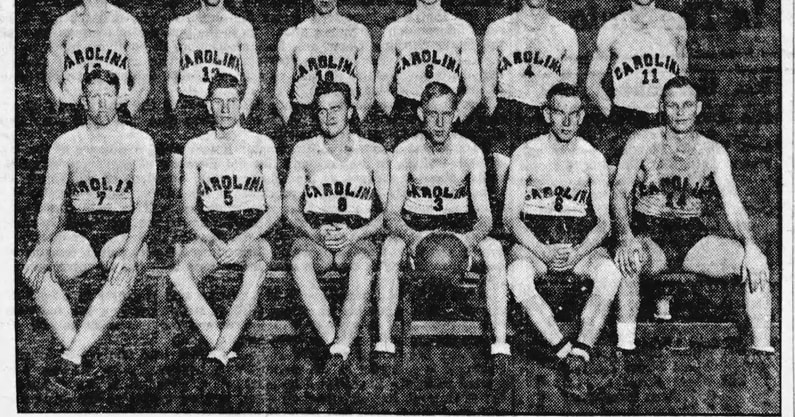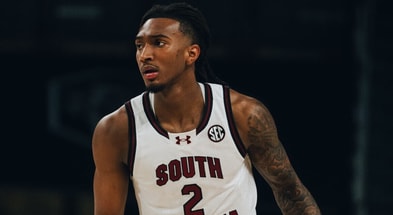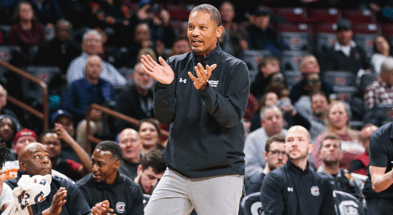Of old banners and shadows of greatness

Alan Piercy is the author of A Gamecock Odyssey: University of South Carolina Sports in the Independent Era (1971-1991). The following was originally published on Alan’s South By Southeast newsletter.
As the 2023-24 Gamecock men’s basketball team makes history, take a glance back at another history-making squad from 91 years ago.
As President-Elect Franklin Delano Roosevelt prepared to take the oath of office for the first of his four terms, a quartet of sophomores from Athens, Texas, elevated Gamecock basketball to unprecedented heights during the winter of 1932-33.
At the dawn of that season, Gamecock coach Billy Laval told reporters of his team, “they’re just a bunch of sophomores” in an unpromising assessment of the season’s prospects. Unknowable then, the super-soph Texans would collectively unleash a run for the ages through the Southern Conference. As the economic pressures of the Great Depression deepened, Gamecock basketball stock was poised for a bull run.
The four most notable cagers of 1932-33 came to Columbia by train from the piney woods of east Texas a year prior. Dana Henderson, a rangy 6-foot-4 center, John Rowland and Bennie Tompkins, both guards, and forward Freddie Tompkins, brother to Bennie, had been recruited to Carolina by prior coach A.W. “Rock” Norman, who had connections in Texas.
They led the 1931-32 freshman team to an undefeated season, outscoring opponents 594-265 over 13 games. Most of their competition hailed from YMCA squads out of Columbia, Florence, and Augusta, industrial teams representing local mills, and even a few high school squads. It remained to be seen how they would perform at the varsity level in the rugged Southern Conference. Laval’s reticence was genuine.
Carolina tuned up with a Jan. 3 exhibition win at Carolina Fieldhouse versus a textile team from Dallas, North Carolina, near Gastonia. Coverage of the contest in The State shared space with other entertainments. “Human seal gives show in Y’s Pool,” read one arresting headline. Ads for tonics and cure-alls – so common at the time – filled space as well, including one for Pinkerton’s Vegetable Compound – “Now I feel full of pep!”
The Gamecock “basketeers” proved full of pep as well, winning 81-8, a promising result no matter the competition. Now, the real work began.
A road trip to start the season
Before Southern Conference play, a four-game tour through newly-formed Southeastern Conference country awaited the young team.
The Gamecocks departed Columbia by bus on Wednesday, Jan. 4, for the trip to Knoxville to face the Tennessee Volunteers. It was a chilly 38 degrees when they departed at 7 a.m. from Carolina Fieldhouse on campus. Interstate highways lay well into the future, and the route between Columbia and Knoxville was a long one for a slow-moving bus full of young men.
Some played cards to pass the time, a few read newspapers or textbooks, and all took intermittent and fitful naps. The bus bounced along through Chapin, near the recently completed Dreher Shoals Dam and Lake Murray. Up through Newberry and Laurens, and the foothills around Greenville, then on through the leafy environs of Travelers Rest. Further north through the mountain hamlets of Slater and Marietta the road narrowed as hills and trees claimed dominion over the more cultivated world below.
The bus kept rolling through North Carolina railroad towns towns like Hendersonville and Fletcher and Waynesville, then crossed into the Volunteer State, through Gatlinburg and Sevierville and Seymour, before finally arriving at Knoxville. It was a full 10 hours of ponderous travel along Southern Appalachian back roads as winter-bare trees revealed glimpses of valleys and pastures and mill villages below.
There was nothing glamorous or easy about traveling for road games in those times, but the team was young and eager and undeterred by mild discomforts in those hardscrabble days. Each new mile revealed places they had never seen, and the adventure of travel through new places was ample reward for the trouble of getting there.
The boys stayed overnight in bunks behind the visitor’s locker room at Tennessee’s Alumni Gymnasium. After a brief walkthrough and a dinner of wrapped sandwiches, the 1933 Gamecock basketball team settled into their spartan bunks as a wood-burning stove glowed and hissed in a corner of the room.
Thursday, Jan. 5 – game day – dawned in the 20’s, considerably colder in Knoxville than the milder environs of Columbia. After a day of restless waiting for tipoff, the visitors opened the season with a 39-29 win, paced by “towering” Dana Henderson’s 10 points. It was Carolina’s second win in the still-young series of four games versus the Volunteers and the first win ever in Knoxville. It also marked the Gamecocks’ first victory over a program in the nascent Southeastern Conference, which it would join some six decades on.
From there, it was onto Sewanee the next day, where the Gamecocks won handily, 55-24. Henderson led the birds once more with 19 points, while Bennie Tompkins contributed 12.
A close loss, 31-29, to Vanderbilt in Nashville followed on Jan. 7, before a long trip along more Appalachian blacktop to Lexington, Kentucky, on Jan. 10. The powerful Wildcats proved too much in that one, downing the Gamecocks 44-36.
After four games and hundreds of miles, the Gamecocks’ record stood at 2-2. They were competitive in each game, but more promising, they had been without their best player, Freddie Tompkins. Tompkins had enrolled late and would not be eligible until Feb. 1 – just in time for a rematch with Kentucky in Columbia.
Carolina would also soon add sharpshooting guard Grayson Wolf of Charleston, described in reports as the “best all-around athlete in the state,” who had decided late to play basketball rather than continue his pugilistic exploits on the boxing team.
Back in the friendly confines of Carolina Fieldhouse
A week after returning home, Carolina hosted Presbyterian College, led by Geech Adams, who the normally verbose John Montgomery of The State described simply as “diminutive.” The Gamecocks led 35-6 at intermission and continued the onslaught after halftime, winning 64-20. Henderson led all scorers with 19.
Clemson came to town next for the first Southern Conference tilt of the season. 2,000 spectators filed into the field house to witness Carolina hand its Upstate rivals a 21-point loss, 47-26. Reports from the game lauded the “alert, speedy basketball” played by both squads. Speculation was that the crowd was the largest to have witnessed a game since Carolina Fieldhouse opened six years earlier. Even the official earned praise. “Referee Blackie Carter handled the contest expertly,” one report enthused. Grayson Wolf, playing his first game of the season, tied Henderson and Bennie Tompkins to lead scoring with 13 apiece.
Now at 4-2 after two blowout wins and Tompkins gaining eligibility, momentum was building for the Gamecocks as the calendar turned to February.
Kentucky rolled into town undefeated on the season and was considered the best team in the South. 4,000 spectators jammed into the 3,200-seat field house, the first sellout in the venue’s history and widely considered the largest crowd ever to witness an indoor sporting event in state history. Members of the Carolina band “added much to the spirit of the occasion,” according to reporting.
The State’s Bill Montgomery described the action in the wordy parlance of the day,
“Both teams exhibited uncanny ability and speed and practically every field goal was made through unerring accuracy under difficult circumstances or through adroit maneuvers.”
Dana Henderson led all scorers with 19 while Freddie Tompkins added 17 in his debut, and the two paced Carolina to a thrilling 44-38 victory over the Wildcats. It was a massive upset win.
Caldwell Withers, columnist for the Columbia Record, added,
“From the ringing rafters of the field house last night came a joyful noise, a howling joyful noise, for the great University of Kentucky basketball team had lost a hectic game, 44-38, to a panting, anxious and expert University of South Carolina team in as exciting a contest as ever presented to a Columbia sports crowd.”
Fans were vocal and engaged throughout, so much so that Irwin Kahn opined in the Feb. 10 edition of The Gamecock student newspaper that “the booing was extremely unpleasant to those who restrained themselves.” He followed that bit of pearl-clutching with a proposed “Code of Sportsmanship for Spectators,” which included such admonitions as, “I will applaud good plays made by either team,” and “I will not ‘razz’ the players or officials connected with either team,” among other high-minded implorements.
We can only imagine the castigations and righteously indignant clacking that might have emanated from young Mr. Kahn’s typewriter after a proper courtstorming.
Top 10
- 1New
Top 25 Shakeup
Big changes in AP Poll
- 2
Neal Brown
Texas targeting former WVU HC
- 3
Women's Hoops Poll
AP Top 25 sees movement
- 4
FSU, Clemson settlement
ACC future taking shape
- 5Hot
Baseball Top 25
New No. 1 team in country
Get the On3 Top 10 to your inbox every morning
By clicking "Subscribe to Newsletter", I agree to On3's Privacy Notice, Terms, and use of my personal information described therein.
From there, the Gamecocks went on a tear, defeating The Citadel, N.C. State, Newberry (twice), Furman, and Erskine, to run their record to 11-2, and 2-0 in the Southern. Only Duke and Clemson remained on the conference ledger, followed by a non-conference tilt versus Furman, then known as the “Purple Hurricanes.”
Carolina dominated the Blue Devils, 46-23 in Columbia, securing a No. 1 seed in the Southern Conference Tournament in the process. The Tompkins brothers led the scoring, Bennie with 19 and Freddie with 11.
A two-game tour of the Upstate followed as the Gamecocks defeated Clemson 36-26 at Fike Fieldhouse and Furman 36-26 in Greenville.
Onto Raleigh for the Southern Conference Tournament
Though Colonial Life Arena has a banner marking the 1933 regular-season Southern Conference title, only tournament winners were recognized as the league champions in those days. With the NCAA Tournament still six years away, conference tournaments marked the height of post-season excitement.
The SoCon tournament had not been kind to the Gamecocks since it joined the league in 1924. Carolina had only earned invitations four out of nine years, resulting in three first-round defeats and one second-round loss. Their only tournament win came in 1927 – a very good year for the Gamecocks – which saw them open a new field house, claim a regular season SoCon championship, and defeat Georgia Tech in the tournament opener before losing to eventual champion Vanderbilt.
In a strange turn of events, there was no defending champion at the 1933 SoCon tournament, as Georgia, winner of the prior year’s tourney, had been amongst the teams that withdrew from the conference to help form the SEC.
Eight of the remaining 10 SoCon teams were invited to the tournament, then hosted annually at Raleigh’s Memorial Auditorium. In the opening round, Carolina faced Maryland, North Carolina squared off with Virginia Polytechnic Institute (Virginia Tech), N.C. State faced Washington & Lee, and Duke took on Virginia.
Carolina dominated Maryland to open tournament play, 65-28. Freddie Tompkins, proclaimed in the Columbia Record as the “long, tall boy from Texas with the spurs of a South Carolina Gamecock,” singlehandedly outscored the Terrapins with a season-high 31 points.
Meanwhile, UNC downed VPI, Duke beat Virginia, and Washington & Lee upset N.C. State. The Tar Heels awaited Carolina in round two.
The Gamecocks won a double-overtime thriller over UNC, 34-32, in the semi-final round. Following the game, Tar Heel coach Bo Shepard bitterly protested an umpire’s decision that awarded Bennie Tompkins a free throw “do-over” late in the second overtime period because the crowd was yelling during the first try. Perhaps Irwin Kahn’s code of sportsmanship for spectators had some influence amongst SoCon officials, if not the spectators themselves.
Carolina faced Duke in the championship round on Monday, Feb. 27. For the second straight game, the Gamecocks found themselves down at the half, but Duke faded late as Carolina earned its fourteenth-straight win and first Southern Conference Tournament championship, winning 33-21.
Back in Columbia, basketball fever ran rampant, as telephones at the offices of The State rang incessantly from shortly after tipoff until almost midnight with basketball fans calling to learn the results of the game.
Freddie and Bennie Tompkins earned tournament all-star recognition, and Raleigh, for that moment at least, belonged to the Gamecocks.
Conquering heroes return home
The champion Gamecocks left Raleigh on a 11:55 p.m. train along the Southern Railway, changing in Charlotte, and arriving at Columbia’s Union Station at 7:45 Tuesday morning to a throng of cheering fans.
Coach Laval gave a few remarks to the several hundred gathered admirers. He praised his team for their resilience and his quartet of Texas sophomores, in particular, for their maturity throughout the season. Conquerers of Tennessee and Kentucky and N.C. State and Duke and North Carolina, the South Carolina Gamecocks were the toast of the South in the winter of 1933. Cheers were given for the garnet & black, and smiles were infectious as handshakes and congratulations were exchanged throughout the station.
After a while, the team made their way outside for the short walk to campus. Though it was cool and overcast with rain predicted, winter was in retreat and glimpses of spring were evident in early dogwood blooms and garnet-hued camellias, and jasmine vines perfumed the air.
Afterward: The 1932-33 Gamecock basketball team remains the only squad in program history to win both the conference regular season and tournament championships in the same year. Coach A.W. “Rock” Norman would return to coach the team for the 1933-34 season, in which the Gamecocks, again powered by Freddie Tompkins, would go 18-1 and win its second-consecutive Southern Conference regular season title.
Beset by a case of the mumps, which sidelined Tompkins and others for the conference tournament, Carolina lost in the first round to N.C. State. In a rare post-tournament game a few weeks later, a healthy Gamecock team defeated Pittsburg, widely considered the top team in the country, 38-35. Carolina’s 32-game winning streak between the 1933 and ‘34 seasons still stands as a program record.

























